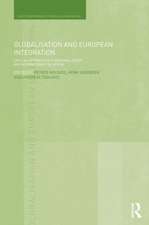Contested Embrace: Transborder Membership Politics in Twentieth-Century Korea: Studies of the Walter H. Shorenstein Asi
Autor Jaeeun Kimen Limba Engleză Hardback – 19 iul 2016
Extending the constructivist approach to nationalisms and the culturalist view of the modern state to a transnational context, Contested Embrace illuminates the political and bureaucratic construction of ethno-national populations beyond the territorial boundary of the state. Through a comparative analysis of transborder membership politics in the colonial, Cold War, and post-Cold War periods, the book shows how the configuration of geopolitics, bureaucratic techniques, and actors' agency shapes the making, unmaking, and remaking of transborder ties. Kim demonstrates that being a "homeland" state or a member of the "transborder nation" is a precarious, arduous, and revocable political achievement.
Preț: 645.98 lei
Preț vechi: 797.51 lei
-19% Nou
123.61€ • 129.38$ • 102.88£
Carte tipărită la comandă
Livrare economică 31 martie-14 aprilie
Specificații
ISBN-10: 0804797625
Pagini: 360
Dimensiuni: 152 x 229 x 25 mm
Greutate: 0.5 kg
Editura: Stanford University Press
Colecția Stanford University Press
Seria Studies of the Walter H. Shorenstein Asi
Recenzii
Notă biografică
Cuprins
This chapter begins with three ethnographic vignettes that reveal the common experiences of colonial-era ethnic Korean migrants and their descendants in Japan and northeast China: forcible separation from and neglect by their state of origin; shifting sense of loyalty and belonging to multiple states involved; efforts to maintain, rebuild, or take advantage of cross-border family ties; and complex dealings with various documentation practices in attempts to reclaim membership in their putative "homeland." The chapter situates the book in the literature on transborder membership politics and discusses its distinctive contributions. Building on a wide range of literature on official classification practices, modern identification techniques, the symbolic power of the state, and the control of cross-border migration, this chapter proposes a set of theoretical arguments about how states' registration and documentation practices contribute to the making, unmaking, and remaking of the "homeland state" and the "transborder nation."
Chapter 1 analyzes the construction of the legal, bureaucratic, and semantic infrastructures of Korean nation-building, which emerged amidst the dramatic transformation of the regional interstate system and the massive intraregional migration in the beginning of the twentieth century. By comparatively examining the colonial state's engagement with Korean migrants in Japan and Manchuria, Chapter 1 shows how these infrastructures helped the colonial state claim migrants of peninsular origin uniformly as "its own"¿if with varying degrees of success¿despite differences among these migrants, their resistance to this compulsory incorporation, and the competing claims made by other states. The colonial state's transborder engagement contributed to the formation of the Korean nation as a legally codified, pervasively institutionalized, and enduringly documented community both inside and outside the colony, providing a critical institutional scaffolding for the diasporic imagination of Korean nationalism and laying the ground for transborder membership politics for decades to come.
Chapter 2 examines the prolonged and vehement competition between North and South Korea over the allegiance of colonial-era Korean migrants who remained in Japan in the context of decolonization and the Cold War. The divergent transborder nation-building strategies that the two postcolonial states employed to make their own docile citizens out of this opaque and recalcitrant population are identified. North Korea launched a successful repatriation campaign and heavily invested in Korean enclaves, presenting itself as a safe haven in which marginalized Koreans could find an escape. South Korea instead fashioned itself as a broker that could facilitate their integration into the Japanese mainstream, and a gatekeeper that could control their engagement with families and home communities in South Korea. The control of the bureaucratic persona of Koreans in Japan, buttressed by the consensual practices of other states, was critical for South Korea's eventual ascendancy in this competition.
The successful incorporation of Koreans who remained in Manchuria into communist China led to their disownment by South Korea, yet this incorporation was not necessarily seen as incompatible with their special tie to North Korea. Chapter 3 examines how China, North Korea, and the Korean Chinese embraced or challenged varying interpretations of this transborder tie, and how they reconfigured the boundary and the meaning of the Korean nation. Beyond the realm of ethnic minority policies, it examines the changing management of several cross-border migration flows (both authorized and unauthorized) as a lens with which to explore the unfolding of this relationship. It shows how various forms of cross-border transactions profoundly shaped the war-making, state-making, and nation-making (or unmaking) processes in both countries, as well as the life trajectories of Korean Chinese who straddled their two fatherlands to navigate the turbulent socialist transition in both countries.
Post Cold-War transborder membership politics gained momentum from the influx of Korean Chinese into South Korea. Chapter 4 highlight the protracted confusion, uncertainty, and indeterminacy that both state and non-state actors in South Korea experienced in trying to "properly" classify the long forgotten ethnonational kin, substantiate their belated claim to membership, and regulate their access to the affluent "homeland." It also reveals the porosity of the walls within which South Korea enclosed itself to exclude the Korean Chinese from transborder membership. On the one hand, Korean Chinese migrants struggled to redefine their collective identity in the legal, political, and public spheres by presenting themselves as an integral part of the Korean nation. But equally importantly, Korean Chinese migrants challenged the state's monopolistic truth claim about their individual identities by engaging in micropolitical struggles in bureaucratic settings, mobilizing alternative genres of identification and creating false paper identities for themselves.
The conclusion recapitulates the book's five main theoretical arguments. It shows how each chapter highlights the fundamentally political, performative, and constitutive nature of transborder nation-building; examines the bureaucratic underpinning of transborder membership politics; reveals its historical nature; demonstrates the importance of the broader interstate system in determining the efficacy of the state's transborder claims-making; and offers a deeply agentic portrayal of transborder membership politics by attending not only to the macropolitics but also to the micropolitics of identity. It also demonstrates the values and the limitations of ethnic nationalism as an analytic category by identifying the historical genesis of the bureaucratic and semantic infrastructures of ethnic nationalism, its variable manifestations (or lack thereof) in different policy domains and repertoires of contention, and its persistence as well as metamorphosis over time. A discussion on the future of transborder membership politics in the contemporary phase of globalization follows.






























